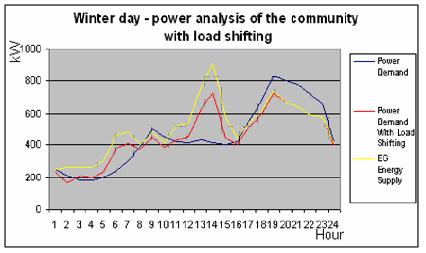DEMAND
AND CARBON EMISSIONS OFFSET
The starting point to the whole carbon
neutral community pathway is the assessment of the demand
and carbon emissions of the community.
The daily energy demand profile is essential in the early
design stage of Renewable Energy supply systems. This is
in order to ensure the optimum sizing in the demand supply
balance analysis enabling accurate costing of systems. However,
the majority of Renewable Energy supply applications are
based on the typical-national demand profile which are supplied
by the DTI or B.R.E.
This can lead to a series of problems associated with either
high installation and equipment costs due to over sizing,
or insufficient supply to cover the load in the case of
under sizing. Especially in medium to big scale applications,
like our case study, the problem can become more serious.
There is a variety of reasons that can make the energy demand
profile of a community to differ for the National-Typical.
Below are some of them:
• Different Housing Stock
• Different types of Occupancy (Households)
• Different occupant consumption behaviour
Hence, a more specific demand profile is
required to reflect the energy loads of the community. This
should be based on the consumption patterns of individuals
and then use these patterns to formulate the community’s
demand profile.
The team has identified that such an approach
in formulating the demand profile should require a rather
simple method suitable for use at the early design stage of
Renewable energy supply. Hence, the Team has developed a method
and then translate this method into a user-friendly tool that
can provide a rough estimation of the energy demand profile
for almost any residential community being analysed.
The tool can be found in the
tools section of this website. For convenience reasons
we slit this tool into the “Electricity demand profile
generator” (E.D.p)
and the “Heating Demand profile generator” (H.D.p).
Both are available in the tools section as well as some explanation
of how they work and what limitations the team faced in terms
of modelling.

With the demand profiles in place, it is
easier to choose which option/s can be taken to offset the
demand and carbon emissions. The options are:
-
-
-

| 1.
Renewable Energy Supply |
Renewable energy is energy that is obtained
from sources that are essentially inexhaustible, unlike
the fossil fuels, of which there is a finite supply. Most
importantly, renewable energy is a source of energy that
does not emit carbon dioxide or/and has zero net carbon
emission.
At the community scale, renewable energy
supplies could be obtained via micro-generation technologies
which include:
Demand and carbon offset by renewable energy
can be further maximized in a community by implementing
“Load shifting” wherever and whenever possible.

In cases where the peaks of the renewable
supplies do not coincide with the peak of the demand, load
shifting could be implemented to make full use of the available
renewable resources.
For instance, the peak of solar radiation,
that is to be harnessed by solar PV, is normally available
during the mid-day due to the varied position of the sun.
However, during a normal weekday, the peak demand for domestic
sector in the UK will only occur during the late evening
of the day. Demand and supply peaks, in this case, do not
coincide with each other which results in wastage of solar
resources.
This excess of solar resources can be met
by shifting the demand peak from late evening to afternoon.
However, this requires changes in consumption pattern and
thus the life style of the domestic users.
Nevertheless, if load shifting can be implemented
on top of renewable energy supply, the remaining demand
and carbon in the community can be offset effectively. The
graphical representation of the load shifting is as shown
in Figure x below.


Other measures that can be taken to offset
the remaining demand and carbon in a community is called
“Green offset”. Green offset can be done by
planting trees in the community and try to avoid cutting
down trees unnecessarily. By carrying out this, the ecosystem
of the area will be more balance where enough trees can
help to absorb the remaining carbon dioxide and produce
more oxygen or fresh air for the residents.
However, the size and the location of the
planted trees must be made sure not to block the wind and
sun light for the use of micro-generation technologies.

|